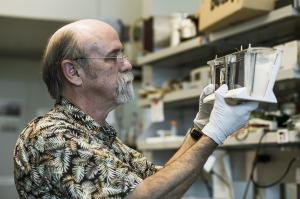UH scientist discovers new approach to potentially stop Alzheimer's Disease in its tracks
University of Hawaiʻi at MānoaUH Med Now Correspondent, John A. Burns School of Medicine
Tina Shelton, (808) 554-2586
Communications Director, John A. Burns School of Medicine
Link to video and sound (details below)
https://spaces.hightail.com/space/sE5392gzal
Dr. Robert Nichols and his collaborators at the University of Hawaiʻi's John A. Burns School of Medicine (JABSOM) may have discovered a potential new way to combat the destructive effects of Alzheimer’s Disease.
They observed that applying a smaller, non-toxic fragment taken from a larger “beta amyloid” peptide in the brain can actually protect the brain's nerve cells and restore normal memory processing. The discovery was unexpected, because high levels of the beta amyloid peptide, in its larger form, is associated with developing Alzheimer’s Disease.
“We believe this is an exciting, new approach, because we are trying to modulate how amyloid is actually acting and causing toxicity in the brain rather than simply lowering it,” Dr. Nichols said. “So we’re delivering this small fragment but the bonus is that this fragment itself seems to be driving neuroprotection in the brain.”
Currently, Dr. Nichols is collaborating with scientists at the University of Arizona to design and screen compounds based on the peptide fragment, for future drug development.
Alzheimer's is the sixth leading cause of death in the U.S., Alzheimer’s Association reports. In Hawaiʻi, the number of people ages 65 and older affected by this disease is expected to rise 25 percent by the year 2025.
Link to video and sound
https://spaces.hightail.com/space/sE5392gzal
Video News Release Contents:
SOUNDBITE #1
Dr. Robert Nichols, Professor of Cell and Molecular Biology, JABSOM
:04-:16 “We believe this is an exciting new approach because we are trying to modulate how amyloid is actually causing toxicity in the brain, rather than just simply lowering it.”
SOUNDBITE #2
Dr. Robert Nichols, Professor of Cell and Molecular Biology, JABSOM
:16-:24 “So we’re delivering this small fragment but the bonus is this small fragment itself seems to be driving neuroprotection in the brain.”
SOUNDBITE #3
Kelly Forest, Graduate Student, JABSOM
:28-:39 “It’s (Alzheimer’s) the sixth leading cause of death in the U.S. but we still can’t find a cure for it because the disorder is so complex.”
SOUNDBITE #4
Dr. Komal Arora, Post-doctorate Fellow, JABSOM
:43-:52 “So it’s rescuing the cells from all the toxic effects, which that 42 amino acid long beta amyloid peptide was exerting on the cells.”
SOUNDBITE #5
Ruth Taketa, Graduate Student, JABSOM
:57-1:12 “The elderly, I mean, they’re the people who have brought us up, and so to be able to prevent them from having these neurodegenerative diseases, and be able to live longer and be able to live a fuller life, is what kind of excites me about our research.”
B-Roll
At :00-:15 Dr. Nichols and his research team in discussion in the medical school’s biosciences building.
At :15-2:08 Lab research work being done in the medical school’s biosciences building.
For more information, visit: http://bit.ly/2JTsTdr

